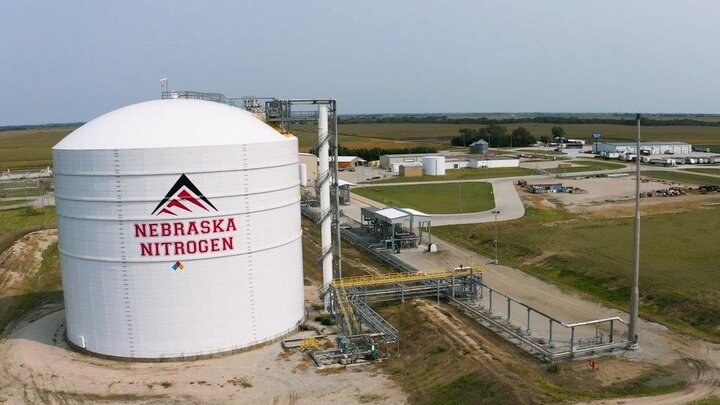2024
“Working with Nebraska MEP and its partners at the University of Nebraska-Lincoln helps us to move forward value driven improvement projects we would not otherwise have the manpower to explore.
These projects help us to improve the operability and efficiency of the plant while reducing our impact on the environment.”
Mark Winters, Engineering Manager, Nebraska Nitrogen
Intern’s sustainability work leads to cost savings and investment at a Nebraska ammonia plant
NE Nitro Geneva LLC dba Nebraska Nitrogen is an anhydrous ammonia fertilizer manufacturing plant based in Geneva, Nebraska that employees 60 people. The operation serves farmers of the western corn belt, providing the necessary fertilizer to allow farmers to sustain soil fertility and crop production. The entire facility produces approximately 100 tons of ammonia fertilizer per day and has a storage capacity of up to 20,000 tons.
The Challenge
The Nebraska MEP, in conjunction with the University of Nebraska (UNL) College of Engineering, reached out to Mark Winters, the plant process engineer, to ask if Nebraska Nitrogen had taken advantage of the University’s P3 (Partners in Pollution Prevention) program. The program places engineering student interns over the summer at manufactures to work on sustainability projects at the client site. During these discussions, Nebraska Nitrogen realized that they could benefit from contracting a P3 engineering student to increase its bandwidth of help and investigate ways to reduce costs and be even more sustainable. Mark had a short list of projects the plant had been wanting to address as it continues to improve its operations.
Matthew Jorgensen of the Nebraska MEP created a scope of work (SOW) with Mark to have a P3 intern work at Nebraska Nitrogen during the 2023 summer session. The SOW defined target project tasks for the intern to investigate and propose implementable recommendations related to plant processes and related equipment.
Of these opportunities, one of the most important aspects of Nebraska Nitrogen’s production is their steam usage. The plant is steam-limited, which becomes even more challenging in the winter. Many of the processes required in producing anhydrous ammonia either use steam as a heat source, as a water source for reactor feed streams, or a combination of the two.
The Solution
The UNL P3 Program and Nebraska Nitrogen jointly placed Jarod Harris, an undergraduate chemical engineering student, to investigate the steam efficacy and ways to improve it, along with further identifying other opportunities for greater operational sustainability of the site’s process streams and their associated equipment during the 2023 summer session of the internship.
As such, Jarod spent much of the summer at Nebraska Nitrogen and examined specific equipment areas of the plant that each involved significant steam use: the waste heat boiler, three auxiliary package boilers, boiler feed water tank, water-gas shift reactor, and the ammonia stripper.
Jarod then complied all the data and analysis and delivered recommendations on options for Nebraska Nitrogen to implement that would improve the above operations. This also included validating Nebraska Nitrogen’s initial short list of potential projects to help with steam use.
The Results
Implementation of the recommendations has increased the energy efficiency per unit mass of ammonia produced that saves the operation of the plant money while also significantly reducing its carbon footprint.
Nebraska Nitrogen is now realizing an annual combined cost avoidance and savings of $290,000. To implement the recommended changes made by Jarod, Nebraska Nitrogen also invested $80,000 in process equipment upgrades.

| $290,000 in annual cost savings |

| $80,000 invested process equipment upgrades |




